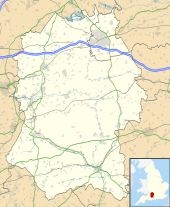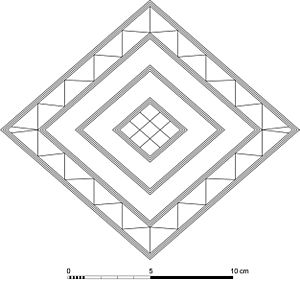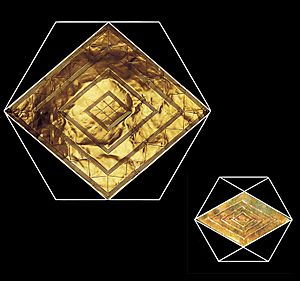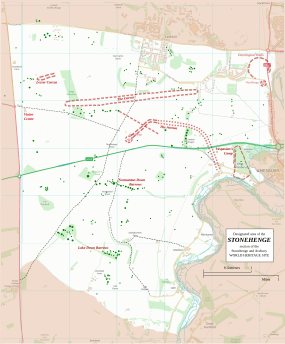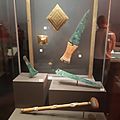Bush Barrow facts for kids
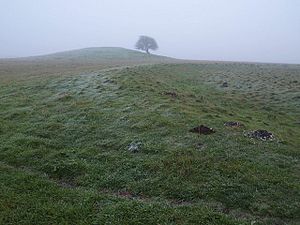
Bush Barrow on Normanton Down
|
|
| Coordinates | 51°10′14″N 1°50′05″W / 51.17051°N 1.834819°W |
|---|---|
| Type | Tumulus |
| Part of | Normanton Down round barrow cemetery |
| History | |
| Periods | Bronze Age |
| Site notes | |
| Excavation dates | 1808 |
| Archaeologists | William Cunnington |
| Ownership | Managed as RSPB Reserve |
| Public access | No (but near bridleway) |
| Website | Wiltshire Museum Gallery |
| Official name | Stonehenge, Avebury and Associated Sites |
| Type | Cultural |
| Criteria | i, ii, iii |
| Designated | 1986 (10th session) |
| Reference no. | 373 |
| Region | Europe and North America |
| Designated | 1925 |
| Reference no. | 1009618 |
Bush Barrow is an ancient burial mound from the early British Bronze Age, around 2000 BC. It is located at the western end of the Normanton Down Barrows cemetery, near Stonehenge. This site is very important because it held some of the most amazing treasures ever found in a British burial.
In 1808, an archaeologist named William Cunnington dug up the barrow for Sir Richard Colt Hoare. The incredible items found there, including gold objects, are now on display at the Wiltshire Museum in Devizes.
Contents
What is Bush Barrow?
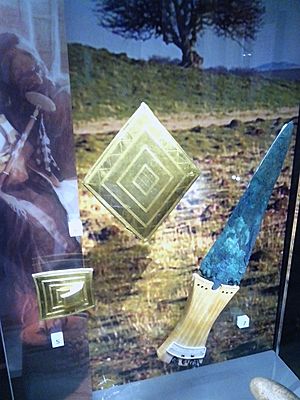
Bush Barrow is about 1 kilometre (0.6 miles) southwest of Stonehenge. It is part of the larger Normanton Down Barrows cemetery. A barrow is a type of ancient burial mound.
The mound itself is about 49 metres (161 feet) wide. It looks like it was built in three different stages over time. Today, the barrow stands about 3.3 metres (11 feet) high. Its flat top is about 10.5 metres (34 feet) wide.
Bush Barrow is part of the Stonehenge, Avebury and Associated Sites World Heritage Site. This means it's a very important place recognized globally for its cultural value. The Normanton Down cemetery has about 40 barrows lined up along a ridge. Bush Barrow is at the highest point of this ridge.
What Was Found Inside?
In 1808, when William Cunnington excavated Bush Barrow, he found the skeleton of a man. With him was an amazing collection of items. These items make it "the richest and most important example of a Bronze Age burial" in all of Britain.
The items found date the burial to the early Bronze Age, between 1900 and 1700 BC. They include a large gold sheet shaped like a diamond (called a 'lozenge'), a gold belt plate, three bronze daggers, a bronze axe, and a stone macehead. All these treasures are now on display at the Wiltshire Museum.
The Bush Barrow Gold Lozenges
The most famous find is the Bush Barrow Lozenge. It's a large, diamond-shaped piece of gold. There was also a smaller gold lozenge. Scientists have discovered that the designs on both lozenges were created using hexagon shapes.
The patterns seem to have been made by repeating hexagons within three circles. This shows that the people who made them were very skilled. They had good tools and understood geometry well. Another similar gold lozenge was found in Clandon Barrow in Dorset.
Bronze Daggers
Among the finds were three bronze daggers. Two of them have the largest blades ever found from that time period. A third dagger had a wooden handle about 30 centimetres (12 inches) long. This handle was decorated with tiny gold studs.
There were up to 140,000 of these tiny gold studs, forming a zigzag pattern. Each stud was only about 0.2 millimetres (0.008 inches) wide and 1 millimetre (0.04 inches) long. More than a thousand studs were placed in every square centimetre of the handle.
Experts believe that only people with very good eyesight, like children or teenagers, could have made such tiny objects. The gold for these items likely came from Ireland, and the dagger itself might have been made in Brittany.
Stone Mace
Next to the skeleton, an unusual stone mace head was found. It was made from a rare type of fossilized sea sponge rock, which came from Devon. This mace had a wooden handle, and parts of its bone decorations, shaped like zigzags, still survive. These decorations remind us of similar items found in ancient Greece and Spain.
An Ancient Knife
Some small pieces of bronze were also found. These were identified as parts of a knife that was at least 200 years older than the other items. This means the knife was made around the same time the famous trilithons (the large stone structures) at Stonehenge were built. It suggests the knife was a treasured antique or family heirloom, buried with the man along with his newer, rich possessions.
Why Was This Burial So Special?
It's a bit of a mystery why Bush Barrow contained such amazing treasures compared to other nearby burial mounds. It sits on the highest point of the ridge, but it's not the tallest barrow. It doesn't look obviously more important than the others.
It's possible that other barrows once held similar treasures, but they might have been stolen long ago. Many items have been found in other barrows in the area, but none compare to the incredible finds from Bush Barrow. This makes the Bush Barrow burial truly unique and special.
Images for kids
-
Bush Barrow contents on display at the World of Stonehenge exhibition in the British Museum


